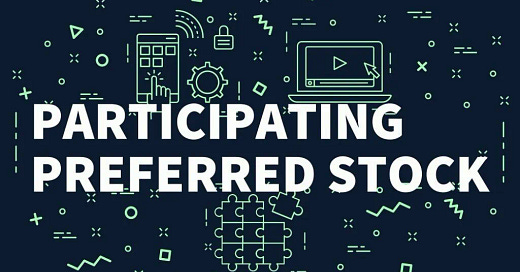Understanding Participating Preferred Stock
The Innovator's Prescription: A Disruptive Solution for Health Care
Dear Subscribers,
Welcome to this edition of our HealthVC Newsletter! Today, we delve into a crucial aspect of venture capital financing - Participating Preferred Stock. This type of equity instrument plays a vital role in structuring investments and protecting the interests of both investors and entrepreneurs. Let's explore what Participating Preferred Stock is all about:
What is Participating Preferred Stock?
Participating Preferred Stock is a class of preferred stock issued by a company to its investors, typically in the context of early-stage startups and venture capital financing. Preferred stock, in general, grants certain privileges and rights to its holders, distinguishing them from common shareholders. The "participating" feature means that, in addition to their preferential treatment during liquidation events, participating preferred shareholders have the right to receive further payouts alongside the common shareholders.
How Does Participating Preferred Stock Work?
In the event of a company's liquidation or acquisition, the participating preferred shareholders receive their initial investment amount back (or sometimes a predetermined multiple of their investment) before any distribution is made to common shareholders. This provides a layer of protection to the investors, ensuring they have a higher chance of recouping their capital.
However, the "participating" aspect goes beyond this point. After the participating preferred shareholders receive their initial investment back, they also have the right to "participate" in the distribution of remaining proceeds with the common shareholders. This participation can either be on an as-converted-to-common-stock basis or on a specific multiple of their initial investment. The aim is to allow investors to benefit from the company's success beyond just their liquidation preference.
Example Illustration:
Let's understand this with an example. Suppose an investor puts $1 million into a startup in exchange for participating preferred stock with a 1x liquidation preference. Later, the startup is acquired for $10 million.
Scenario 1: Acquisition Value < Investor's Investment
The investor receives $1 million (initial investment) and nothing more, as there are no remaining proceeds after the liquidation preference is paid out.
Scenario 2: Acquisition Value > Investor's Investment
The investor receives $1 million (initial investment) first.
If there are any remaining proceeds after paying the liquidation preference, the investor also participates in the distribution alongside common shareholders. In this case, if there's an additional $5 million available for distribution, the investor could receive an extra $1 million, assuming a 1x participation rate.
Why is Participating Preferred Stock Used?
Participating in Preferred Stock serves as a compromise between the interests of investors and entrepreneurs. It provides investors with some downside protection through the liquidation preference while incentivizing them to support the company's growth and success by allowing them to participate in the upside during exits.
For entrepreneurs, offering participating preferred stock may be a trade-off for attracting investors, as it gives investors more security in the event of a lower valuation exit. However, entrepreneurs should be mindful of the dilution impact on their ownership and control in the company when using this type of equity instrument.
Final Thoughts:
Participating in Preferred Stock is a vital element of venture capital financing that impacts the dynamics between investors and entrepreneurs during liquidity events. Understanding the implications of using this type of equity instrument is crucial for both parties involved in the fundraising process.




